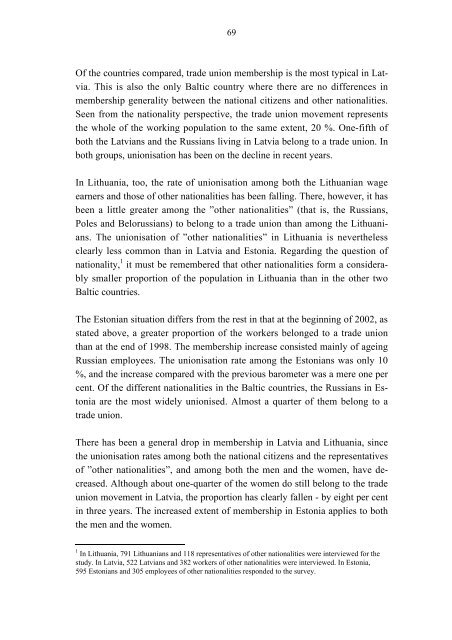Working Life Barometer in the Baltic Countries 2002 (pdf) - mol.fi
Working Life Barometer in the Baltic Countries 2002 (pdf) - mol.fi
Working Life Barometer in the Baltic Countries 2002 (pdf) - mol.fi
You also want an ePaper? Increase the reach of your titles
YUMPU automatically turns print PDFs into web optimized ePapers that Google loves.
69<br />
Of <strong>the</strong> countries compared, trade union membership is <strong>the</strong> most typical <strong>in</strong> Latvia.<br />
This is also <strong>the</strong> only <strong>Baltic</strong> country where <strong>the</strong>re are no differences <strong>in</strong><br />
membership generality between <strong>the</strong> national citizens and o<strong>the</strong>r nationalities.<br />
Seen from <strong>the</strong> nationality perspective, <strong>the</strong> trade union movement represents<br />
<strong>the</strong> whole of <strong>the</strong> work<strong>in</strong>g population to <strong>the</strong> same extent, 20 %. One-<strong>fi</strong>fth of<br />
both <strong>the</strong> Latvians and <strong>the</strong> Russians liv<strong>in</strong>g <strong>in</strong> Latvia belong to a trade union. In<br />
both groups, unionisation has been on <strong>the</strong> decl<strong>in</strong>e <strong>in</strong> recent years.<br />
In Lithuania, too, <strong>the</strong> rate of unionisation among both <strong>the</strong> Lithuanian wage<br />
earners and those of o<strong>the</strong>r nationalities has been fall<strong>in</strong>g. There, however, it has<br />
been a little greater among <strong>the</strong> ”o<strong>the</strong>r nationalities” (that is, <strong>the</strong> Russians,<br />
Poles and Belorussians) to belong to a trade union than among <strong>the</strong> Lithuanians.<br />
The unionisation of ”o<strong>the</strong>r nationalities” <strong>in</strong> Lithuania is never<strong>the</strong>less<br />
clearly less common than <strong>in</strong> Latvia and Estonia. Regard<strong>in</strong>g <strong>the</strong> question of<br />
nationality, 1 it must be remembered that o<strong>the</strong>r nationalities form a considerably<br />
smaller proportion of <strong>the</strong> population <strong>in</strong> Lithuania than <strong>in</strong> <strong>the</strong> o<strong>the</strong>r two<br />
<strong>Baltic</strong> countries.<br />
The Estonian situation differs from <strong>the</strong> rest <strong>in</strong> that at <strong>the</strong> beg<strong>in</strong>n<strong>in</strong>g of <strong>2002</strong>, as<br />
stated above, a greater proportion of <strong>the</strong> workers belonged to a trade union<br />
than at <strong>the</strong> end of 1998. The membership <strong>in</strong>crease consisted ma<strong>in</strong>ly of age<strong>in</strong>g<br />
Russian employees. The unionisation rate among <strong>the</strong> Estonians was only 10<br />
%, and <strong>the</strong> <strong>in</strong>crease compared with <strong>the</strong> previous barometer was a mere one per<br />
cent. Of <strong>the</strong> different nationalities <strong>in</strong> <strong>the</strong> <strong>Baltic</strong> countries, <strong>the</strong> Russians <strong>in</strong> Estonia<br />
are <strong>the</strong> most widely unionised. Almost a quarter of <strong>the</strong>m belong to a<br />
trade union.<br />
There has been a general drop <strong>in</strong> membership <strong>in</strong> Latvia and Lithuania, s<strong>in</strong>ce<br />
<strong>the</strong> unionisation rates among both <strong>the</strong> national citizens and <strong>the</strong> representatives<br />
of ”o<strong>the</strong>r nationalities”, and among both <strong>the</strong> men and <strong>the</strong> women, have decreased.<br />
Although about one-quarter of <strong>the</strong> women do still belong to <strong>the</strong> trade<br />
union movement <strong>in</strong> Latvia, <strong>the</strong> proportion has clearly fallen - by eight per cent<br />
<strong>in</strong> three years. The <strong>in</strong>creased extent of membership <strong>in</strong> Estonia applies to both<br />
<strong>the</strong> men and <strong>the</strong> women.<br />
1 In Lithuania, 791 Lithuanians and 118 representatives of o<strong>the</strong>r nationalities were <strong>in</strong>terviewed for <strong>the</strong><br />
study. In Latvia, 522 Latvians and 382 workers of o<strong>the</strong>r nationalities were <strong>in</strong>terviewed. In Estonia,<br />
595 Estonians and 305 employees of o<strong>the</strong>r nationalities responded to <strong>the</strong> survey.

















